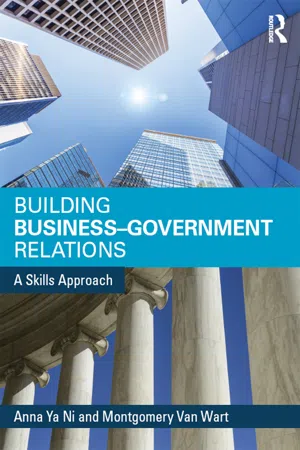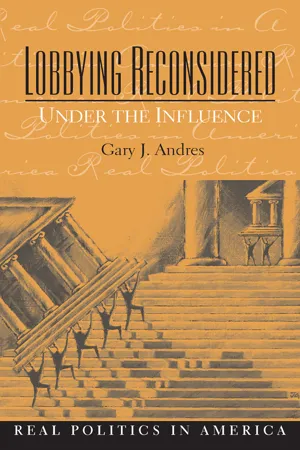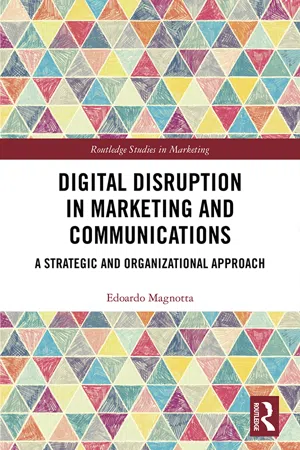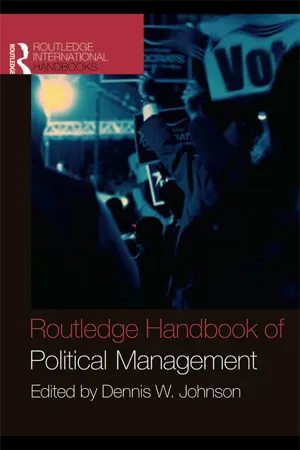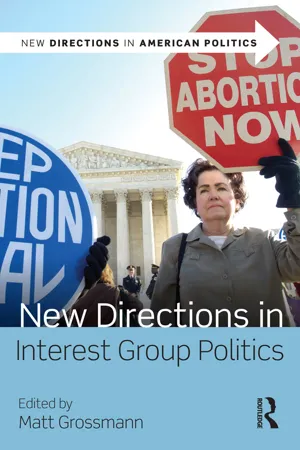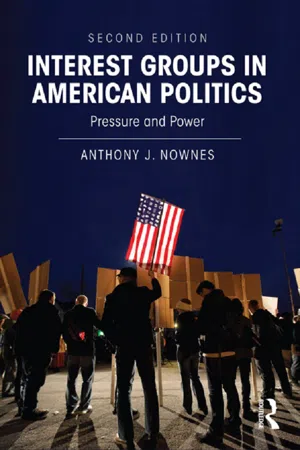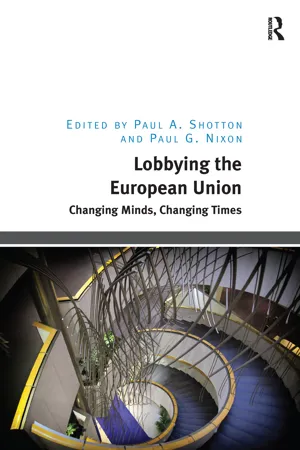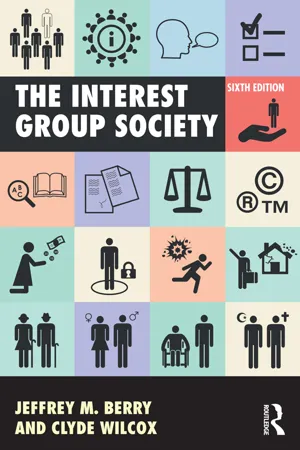Politics & International Relations
Lobbying
Lobbying refers to the practice of individuals or groups attempting to influence government decisions, typically by advocating for specific policies or legislation. This can involve activities such as meeting with lawmakers, providing information, and making campaign contributions. Lobbying is a common practice in many political systems and is often conducted by professional lobbyists or interest groups representing various industries or causes.
Written by Perlego with AI-assistance
Related key terms
Related key terms
1 of 4
Related key terms
1 of 3
9 Key excerpts on "Lobbying"
- eBook - ePub
Rethinking Public Relations
Persuasion, Democracy and Society
- Kevin Moloney, Conor McGrath(Authors)
- 2019(Publication Date)
- Routledge(Publisher)
3 These techniques can be deployed to protect and protect the structural power of big business, or to challenge and expose that power. Fundamentally, though, Lobbying is undertaken for competitive advantage, to achieve some policy gain. We say again that public relations is instrumental, not idealistic.Not for the first time, we have here a feature of PR practice which is bedevilled by a host of diverse academic and professional definitions. As a part of everyday language, ‘Lobbying’ is generally understood by most of us more or less straightforwardly as an exercise in influence: “Lobbying, in effect, is no more than endeavouring to get folks ‘on your side’” (Collison, 1978: 32); and Lobbying is “attempting to influence government decisions” (Nownes, 2001: 8). In those nations which have adopted Lobbying registration or regulation, there are legal definitions of what constitutes ‘Lobbying’. These tend to focus on the act of communicating with a policymaker in order to influence public policy, and yet this is often the smallest part of a lobbyist’s job. Most practitioners spend most of their time monitoring the activities of parliament and government, more general information-gathering in the socio-political arena, then applying the knowledge gained to the preparation of corporate policy papers, developing and maintaining appropriate contact with key decision-makers and other stakeholders, and only at the end of a lengthy process actually seeking to persuade politicians and civil servants of a client or employer’s case. Boiled down to its essentials, Lobbying is about knowing who makes decisions about public policy which affect your group or organisation’s interests, how and when to influence them; but it is important to understand that even more fundamental to Lobbying than influence is information provision and persuasive communication. Lobbying, like other areas of PR, is a rhetorical exercise in which the art of finding the most persuasive way of framing an argument can determine effectiveness.4 - eBook - ePub
Building Business-Government Relations
A Skills Approach
- Anna Ni, Montgomery Van Wart(Authors)
- 2015(Publication Date)
- Routledge(Publisher)
Matters get even more complicated when it comes to international-level Lobbying. National differences and the lack of one undisputed decision-making body add an additional layer of complexity to international Lobbying that is not present at the national level. Those who lobby at the international level can approach a number of parties such as non-governmental organizations like the International Monetary Fund or World Bank, or can lobby foreign governments in part. Reaching consensus or change at the international level is much more difficult and expensive than doing so either nationally or locally. Lobbying at the international level seldom yields immediate results and at times might take a decade for a desired change to take place.Business has several decisions to make before engaging in Lobbying (Rival 2012 ). First, it has to determine what kind of Lobbying strategy is preferred—active, anticipatory, or passive. It then needs to decide on the number of issues to lobby and the desired outcomes. Usually firms either attempt to maximize gains or minimize losses. A third important decision that has to be made regards the entity engaged in the Lobbying activity. For instance, businesses can choose between having internal lobbyists and hiring someone from outside. Firms also have the choice to lobby separately or collectively. In addition to determining who is going to lobby for the firm, the business has to also consider the target of the Lobbying. Two particularly important questions are who (politicians, public agencies) or what level (local, national, international) the Lobbying campaign will target. A final— and major—decision is the manner in which the Lobbying will be done. There are several options available to business: they can use direct or indirect pressure, interact with legislators, or employ a combination of both.One lesser-known fact about Lobbying is that lobbyists’ work does not stop with the passage of a legislative package. Every piece of legislation that is ever created, even if it is hundreds of pages long, almost never goes into enough detail to account for all possible scenarios during its implementation. It is an accepted fact of public administration that public agencies have to interpret the ambiguity of legislative mandates, hence becoming active shapers of public policy. Legislators, for political reasons, habitually use vague terms and conditions; such tactics ensure that there will likely be fewer reasons to motivate a political impasse. Yet public agencies cannot rely on ambiguous language during implementation. They have to clarify what politicians were undecided about, couldn’t agree upon, or did not know how to resolve and therefore passed on to public agencies. - eBook - ePub
Lobbying Reconsidered
Politics Under the Influence
- Gary Andres, Paul Hernnson(Authors)
- 2015(Publication Date)
- Routledge(Publisher)
21Students of Lobbying need to move beyond just looking for evidence of persuasion. Focusing more on the information gathering/uncertainty-reducing behaviors and agenda-setting of lobbyists helps develop a much clearer and realistic understanding of what interest groups and their advocates actually do.Context also matters when it comes to understanding the advocacy world. Lobbying investments and tactics change based on a variety of factors, including the resources an interest group possesses, the competitive pressures it faces, the air cover/ground cover demands, the visibility of the issue, the role of allies, willingness to adapt new tools, the level of conflict, whether they are playing offense or defense, and the partisan atmosphere. Moreover, the type of policy under consideration also affects Lobbying. Just as the politics of the decision-making systems vary based on factors such as the visibility of the decision, the scope of the conflict, and the number of participants, these changing contexts also influence the Lobbying tactics deployed.22Partisan context deserves a special note. As I argue in this book, partisanship is one of the defining characteristics of politics in Washington in the first part of the twenty-first century. Yet its impact on Lobbying remains largely unexplored. For example, after the 2000 election, a more conservative, pro-business environment existed in Washington due to unified control of Congress and the White House by Republicans for the first time in almost a half century. Did business back off after 2001 because of lack of risk? Did labor and environmental groups ramp-up their activities because they had to play defense? And how did business and labor respond to the new context in 2007? Did labor rest on its laurels or view the new Democrat Congress as a place to play offense for the first time in over a decade? Similarly, did business beef up its Lobbying presence because of the new challenges in DC? - eBook - ePub
Digital Disruption in Marketing and Communications
A Strategic and Organizational Approach
- Edoardo Magnotta(Author)
- 2019(Publication Date)
- Routledge(Publisher)
Lobbying activities use information, big data, competencies and capabilities to build a bridge of different meanings between economic and political world. Lobbying is a communication activity that was typically born in the politics. All the national media in the western countries are usually represented in the government lobby organisations, groups of journalists representing a very important resource that governments use for keeping control of information flows to the media and hence to the wide audience. It remains the best way for political journalists to get the up-to-date position of the government on a developing news story. 2 In the perspective of the political communication, media management activities aim at keeping a positive media relationship, at acknowledging the each other needs, as well as at exploiting the institutional characteristics of both sets of stakeholders for maximum advantage. 3 At the same time, the relationship between politicians and media almost always implies a struggle between two contrasting sets of interests and agendas, as journalists aim at telling facts-based stories, while politicians aim at telling a new story reflecting the message that they wish to convey. In this perspective, the role of the message is extremely important as mean to influence public opinion and achieve political, economic and sociocultural transformation. Public relations and public affairs should come together to build, develop and keep advantageous relationships aimed at exploiting specific interests. To that aim, the meaning and the “truth” of the message is crucial. As we have seen in Chapter 4, the storytelling is a very powerful mean to convince and engage - eBook - ePub
- Dennis W. Johnson(Author)
- 2010(Publication Date)
- Routledge(Publisher)
Part 4 Lobbying, Advocacy, and Political PersuasionPassage contains an image
29 The Creation of the US Lobbying Industry
Conor McGrath and Phil HarrisDOI: 10.4324/9780203892138-33Introduction
A recent article asserts that “political scientists know precious little about the contours of interest group politics in the United States before the 1960s.”1 Although no definitive history of Lobbying has been produced—and indeed, none may be possible, given that no systematic archive exists of records kept by early lobbyists—it is nevertheless possible to trace some outlines of the industry’s early development. We certainly lack many wide-ranging empirical studies of historical Lobbying and it is true that few theoretical models are tested other than in contemporary settings, but we can draw upon a wealth of anecdotal and journalistic information about the activities of lobbyists prior to the modern era. What is most striking from such an overview is the extent to which some of the tactics and techniques used by the industry’s pioneers, and the debates over their legitimacy, are familiar to today’s observers of the Lobbying scene.Confusion surrounds even the origins of the words “Lobbying” and “lobbyist.” While “lobby” as a noun, denoting the halls of a legislature in which elected officials may meet with non-members, can be traced back to the seventeenth century, its use as a verb (“to lobby”) began in the second half of the nineteenth century according to the Oxford English Dictionary. The OED supplies quotes from the period: “Lobbying [is] buying votes with money in the lobbies of the Hall of Congress” (1864); and “The arrangements of the committee system have produced and sustain the class of professional ‘lobbyists’ who make it their business to ‘see’ members” (1888).2 An early journalistic account of Lobbying dates the use of the term “lobby-agent” to 1829, and asserts that by 1832 “lobbyist” was a well-recognized term in Washington.3 Certainly, it is apparent that by 1847, these terms had been in usage for some time, as one writer discussed “the third house, or lobby, which is always so potent in giving direction to American legislation.”4 The second edition of Webster’s Dictionary that same year defined “lobby-member” as “a person who frequents the lobby of a house of legislation.”5 Yet another source suggests that the word “lobby” was first used to denote those seeking to influence legislation in 1808—which, if true, means that we have been using it for 200 years.6 Deanna Gelak (a former president of the American League of Lobbyists) has traced the word “Lobbying” to an article in the April 1, 1820, edition of the New Hampshire Sentinel - eBook - ePub
- Matt Grossmann(Author)
- 2013(Publication Date)
- Routledge(Publisher)
Chapter 10 Understanding the Influence of Lobbying in the U.S. Congress Preferences, Networks, Money, and Bills Holly Brasher and Jason BrittOne of the central questions associated with Lobbying is whether interest groups can influence outcomes in Congress through their Lobbying activity. They are widely assumed to do so. In an interview about the legislative process associated with fiscal cliff negotiations, a senator made the following observation:Look, I’m not in the room so I can’t say with certainty, but I am very hopeful that they are making progress. And look, it would be wise on their part not to come too quickly with a deal, because that would give all the interest groups a chance to get organized and try to kill it. And we know that on the right, on the left, special interest groups are just salivating at the chance to attack any agreement.1Along with members of Congress, the American public also perceives interest groups to have an important influence. Currently a majority of the American public does not approve of the performance of the U.S. Congress and some of the cynicism toward the institution comes from the perception that Congress serves special interests rather than the public interest.2For the functioning of American democracy, this question is of great significance. If Lobbying does influence policy outcomes, then it shapes sweeping decisions about the allocation of federal money, legal rights, and monetary benefits for large groups in society as well as smaller and more narrowly targeted decisions about the development of solid oxide fuel cells by defense contractors, hospital payments for graduate medical education, and Grand Canyon air tour curfews.A recent example of Lobbying activity can be seen with the Marketplace Fairness Act, a bill that would require online retailers to collect sales taxes for state and local government from their Internet sales. The Marketplace Fairness Act attracted an array of interest groups Lobbying on both sides of the issue with Wal-Mart and the National Retail Federation Lobbying in favor of the legislation and online retailer eBay leading opponents of the bill.3 - eBook - ePub
Interest Groups in American Politics
Pressure and Power
- Anthony J. Nownes(Author)
- 2013(Publication Date)
- Routledge(Publisher)
7 Indirect Lobbying It makes sense to assume that interest groups lobby only government decision-makers. After all, government decision-makers are the people who make government decisions. Who else would interest groups lobby? The answer, it turns out, is you and me. Numerous studies of Lobbying show that interest groups often lobby ordinary citizens who have little or no power directly to make government decisions. This sort of Lobbying, Lobbying that is aimed at ordinary people rather than government decision-makers, is called “indirect Lobbying,” and is the subject of this chapter. I begin by exploring what indirect Lobbying is. As you will see, indirect Lobbying has one hugely important thing in common with direct Lobbying— its goal is to influence government decisions. Next, I ask: Why do interest groups engage in indirect Lobbying? The answer to this question lies in the very nature of our representative democracy. From here, I examine the techniques by which interest groups lobby citizens. As with direct Lobbying, interest groups have a number of distinct techniques at their disposal. I conclude with a look at recent trends in indirect Lobbying. Though indirect Lobbying has been around for a long time, it is more common now than ever before. What is Indirect Lobbying? Indirect Lobbying is defined as Lobbying that is aimed at citizens rather than government decision-makers. It is important to note that some people refer to indirect Lobbying as “grassroots Lobbying,” which is defined as Lobbying aimed at ordinary citizens which is designed to mobilize them to contact legislators and/or other decision-makers. In addition, some people call indirect Lobbying “outside Lobbying.” The term “indirect Lobbying” is preferable for two reasons. First of all, not all Lobbying that is aimed at citizens is designed to mobilize them to contact legislators and other government decision-makers. Some is designed to shape people’s attitudes and opinions - eBook - ePub
Lobbying the European Union
Changing Minds, Changing Times
- Paul A. Shotton, Paul G. Nixon(Authors)
- 2020(Publication Date)
- Routledge(Publisher)
Chapter 8 A Practical Guide to European Union Lobbying CampaignsNatacha Clarac and Stéphane DesselasThis chapter provides a wide reaching and practical guide to successful EU Lobbying. The methodological toolkit developed below is born out of several years of professional activity to promote various interests in the EU arena. After reading this chapter, you will better understand what you need to know and do in order to act effectively in trying to shape EU decisions specifically addressing your interests. This chapter answers to the unspoken, yet widely spread, question: why bother about Lobbying? Firstly, because there is nothing taboo about Lobbying. Secondly, it is not difficult to set up and to carry out a Lobbying campaign. Thirdly, it makes a difference to how public policies evolve, if you have the adequate tools. This chapter really is for groups or organizations that seek to build their capacity and effectiveness in European public policy advocacy. Whatever entities you represent from NGOs to big business, the process of creating an advocacy campaign and carrying it out is broadly similar for all kinds of stakeholders. Obviously, a Lobbying campaign is always carried out facing many internal and external constraints and under severe time pressure. Yet, with a rationalized methodology, it is still possible to be successful.A Lobbying campaign is essentially a three step process:1. Getting the most precise and up-to-date information2. Taking a position3. Acting with a sound mix of direct and indirect LobbyingThis chapter describes and illustrates each step which constitutes the framework of any Lobbying campaign. It might be useful to give a reminder here that your Lobbying strategy will always take place within a given schedule driven by the European institutions. This explains why good monitoring of their policy timetables is a key to success.Part One: Be Well Informed
Being well-informed encompasses two different and successive elements. The more widely known is the monitoring of EU initiatives. This section will briefly give the “what you need to know” in order to set up a good monitoring system (step one). A lesser known – yet equally essential – part of the work is the preparation of the case, meaning the evaluation of your position within the broader EU context (step two). - eBook - ePub
- Jeffrey M. Berry, Clyde Wilcox(Authors)
- 2018(Publication Date)
- Routledge(Publisher)
Contrary to the image of lobbyists as backroom operators, much of their time is taken up in trying to be visible. They spend valuable time at congressional hearings even though nothing of great consequence is likely to happen there—it is a chance to touch base with other lobbyists and congressional staffers. They will make repeated visits to different Capitol Hill offices, even if all they are likely to accomplish is leaving a message with a secretary that they had stopped by to see the administrative assistant. They will attend fundraising events in the evening, personally handing over a PAC contribution and using the opportunity to remind members or their aides whom they represent. Much of what a lobbyist does is to remind legislators, staffers, and other lobbyists that they represent a group whose views ought to be considered when policy decisions are being hammered out. This does not mean that lobbyists always claim credit for their victories—indeed one corporate lobbyist notes that “when I do my best for my company, there are no fingerprints on a bill.”Washington representatives also keep in touch with interest group allies of all sizes and types. The constant interaction is a means for exchanging information, but it also affords an opportunity to develop strategy, offer and receive moral support, and politely push the other group to do more. In recent years, coalitions have become more important in legislative action, and lobbyists have increasingly coordinated their efforts with others from other groups or firms.Lobbyists differ, of course, in the way they carry out their job. In part, this may depend on the resources of the groups they represent. Public interest lobbyists are not as likely as their counterparts from large corporations to show up at congressional fundraisers, because they represent groups that may not have PACs. Some lobbyists are able to rely on letters written by their constituents to aid their efforts; others do not have large memberships on which to draw. Some lobbyists seek to attract media attention to their efforts; others work on issues far from the public eye.These descriptions have dealt only with legislative Lobbying. Trying to influence the content of a regulation involves considerably less time prowling the corridors than Lobbying on Capitol Hill. There are various reasons for this: To begin with, an agency usually has fewer relevant offices to visit on forthcoming regulations. More important, though, the civil servants who do the lion’s share of the work in drafting regulations can feel constricted in their relations with lobbyists. They may take the attitude that frequent meetings with industry representatives can compromise their neutrality. Ex parte rules prohibit private communications between group representatives and agency officials when a case involving the group is underway. At the same time, bureaucrats recognize that meetings with interest group representatives can help them learn what all the facts are. At some agencies, officials cannot do their jobs without data supplied to them by industry representatives.
Index pages curate the most relevant extracts from our library of academic textbooks. They’ve been created using an in-house natural language model (NLM), each adding context and meaning to key research topics.
Explore more topic indexes
Explore more topic indexes
1 of 6
Explore more topic indexes
1 of 4

